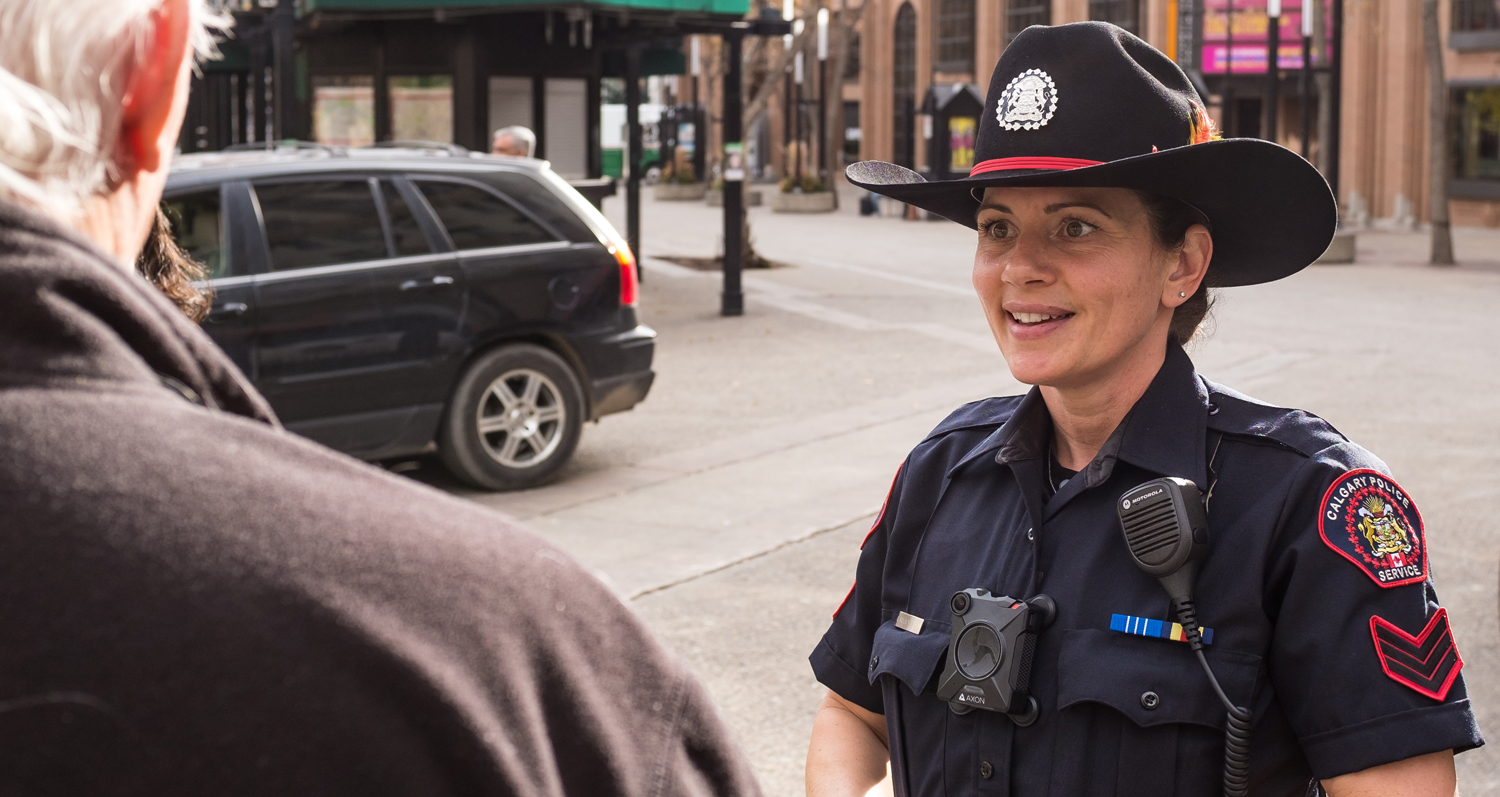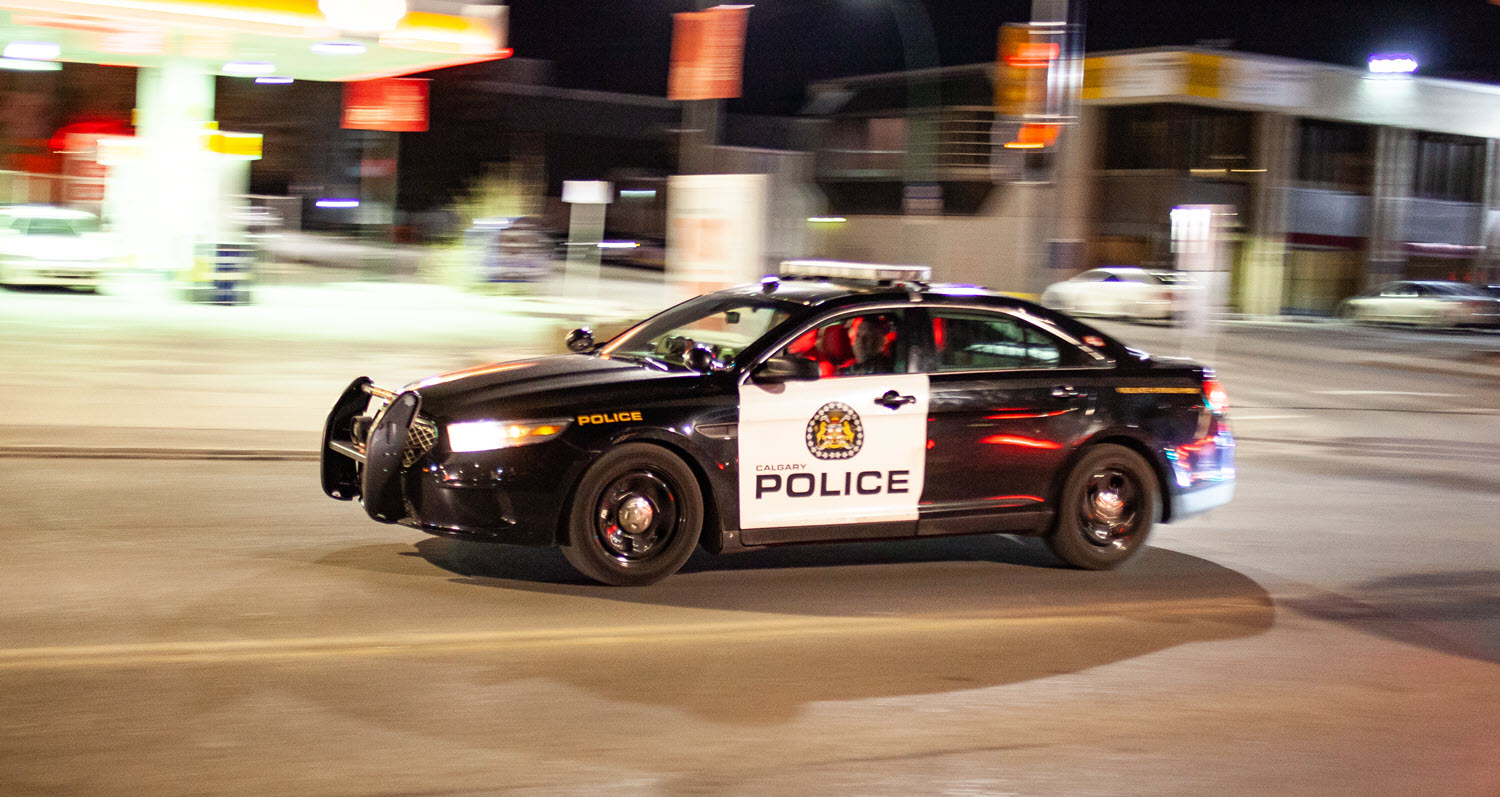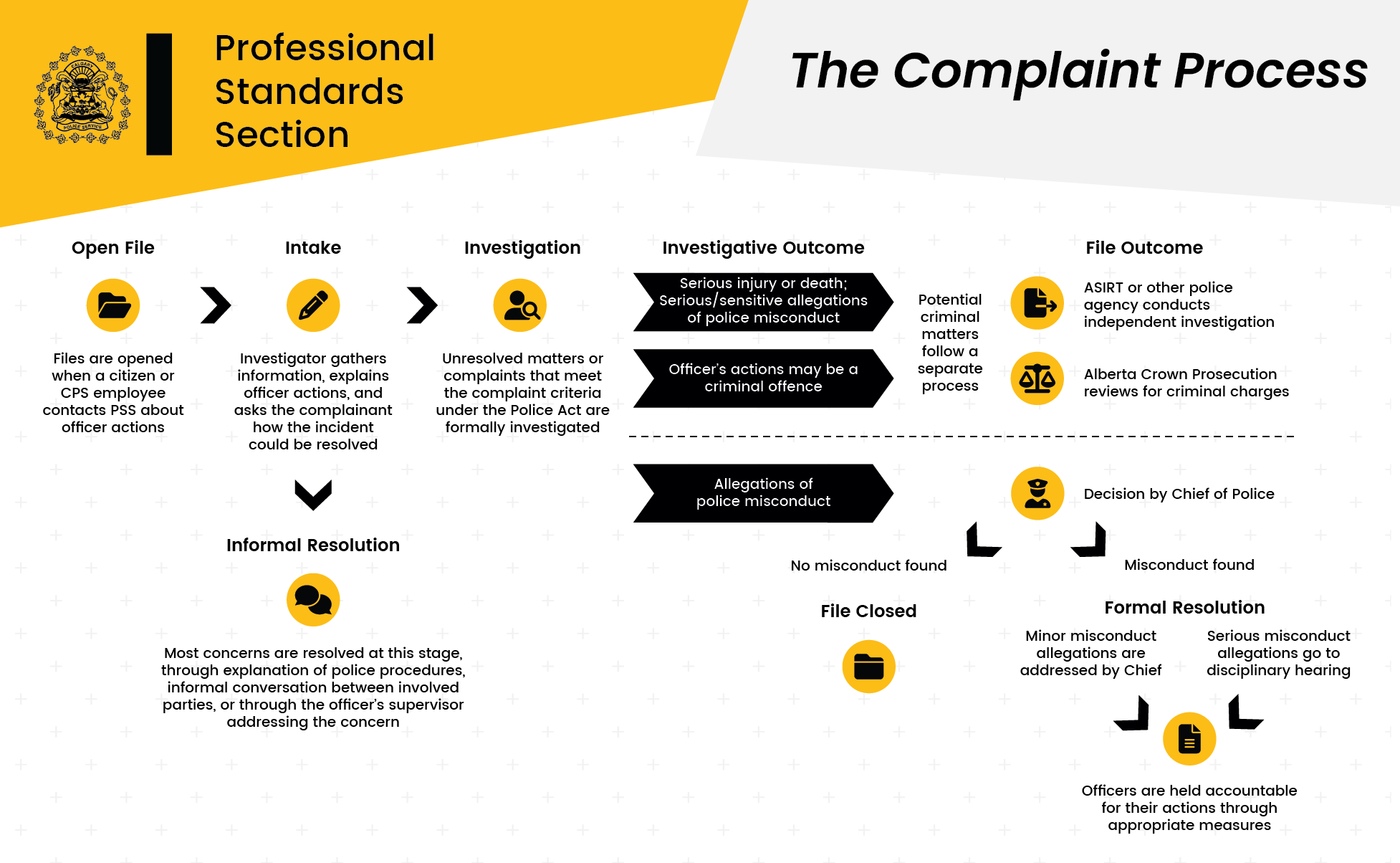Body-worn and in-car cameras
Police officers are entrusted with extraordinary powers and often work in dynamic and high-conflict situations. Cameras that record police interactions with the public can play a crucial role in protecting both the public and our officers, as well as supporting a fair justice system.
Our cameras
At the Calgary Police Service, we have two types of cameras that our frontline officers use:
Body-worn cameras

Patrol officers, traffic officers and some specialty officers carry a camera approximately the size of a pack of cards on the front of their uniform. The officers turn the camera on and off to record audio and video for law enforcement purposes. Every recording includes the 30 seconds before the camera was activated.
These cameras have a light that visibly indicates it is recording. However, officers can disable this when required for officer safety (for example, if the light would give away their location at a nighttime incident involving a person with a firearm).
Officers are expected to use these cameras whenever they have an interaction with the public, and especially when:
- An arrest or detention is likely or happening
- The use-of-force is possible
- They are having an investigative contact with the public
- A legal demand is being made
- A charge is being laid
Officers are not required to tell you they are recording, but we train them to do so when they can.
In-car cameras

Frontline police vehicles are equipped with both dash cameras and back seat cameras that record audio and video. They are automatically activated when the emergency lights are turned on or when the vehicle is involved in a collision.
These cameras constantly store 30 seconds of footage, so every recording includes the 30 seconds before the cameras were activated and ends only when an officer manually shuts them off.
Officers are expected to use these cameras whenever they have an investigative contact with the public, are transporting an arrestee, are in a pursuit, or if it would benefit an investigation.
Privacy concerns
A privacy impact assessment was completed in January 2019 to assess and mitigate any risks posed to privacy through the use of body-worn cameras. Any recording made by either of our cameras are subject to Alberta’s Access to Information Act and Health Information Act when officers are in healthcare facilities.
The recordings are disclosed to the courts when required, but private information of third parties captured in any recording is first redacted.
Effectiveness of cameras
In-car cameras have been used by our Service since 2012 and body-worn cameras were deployed to all patrol members, the Traffic Section and some other frontline officers in April 2019.
Evaluations of our officers’ use of both body-worn and in-car cameras have found evidence that the technologies help create a more efficient accountability process and reduce incidents where force is used.
When body-worn cameras were deployed, we had five goals in mind:
- Enhancing transparency, public trust and confidence
- Enhancing officer accountability and professionalism, and providing real-life training examples
- De-escalating situations and reducing incidences of the use-of-force by and against the police by affecting the behaviour of individuals who are aware of the recording in progress
- Protecting officers from unfounded allegations of misconduct and increasing the efficiency of the resolution of complaints against the police
- Improving evidence collection, documentation, and prosecution, including early case resolution
Reviews of both camera systems were conducted in late 2020 to evaluate the impact of these tools, provide improvement recommendations and help guide future strategic decisions.
Governing policy
Use of body-worn camera at the CPS is governed by the Body Worn Cameras policy. The policy can be viewed here:
Complaints process
If you believe an officer is not using a body-worn camera appropriately, you may file a complaint with the CPS Professional Standards Section.
Police officer performance and accountability are government by the Police Act and Police Service Regulation. The Act sets out the requirements of a valid complaint and outlines the process for filing a complaint.
The CPS Professional Standards Section opens a file when it receives information from a citizen, or when asked by the Chief Constable or his designate to investigate any perceived misconduct, including Police Service Regulation breaches and criminal acts.

Evaluation reports
An evaluation of the body-worn camera project was conducted from June to November 2020 to assess the first year of body-worn camera operations, impact on key groups and baseline measures, such as complaints against officers and use-of-force incidents.
An evaluation of CPS in-car camera operations was also conducted.
You can read the full reports below:
Body-worn Camera 2024 Evaluation Report
Frequently Asked Questions
When did the CPS start using body-worn cameras?
In January 2019, the Calgary Police Service (CPS) fully implemented the use of body-worn cameras.
How much does it cost for the CPS to utilize body-worn cameras?
The use of body-worn cameras requires many staff and resources that are dedicated to implementing and operating the CPS program. The program costs about $5 million annually to operate, including hardware, software licensing and staffing.
Why does the CPS use body-worn cameras?
Cameras that record police interactions with the public can play a crucial role in protecting both the public and our officers, as well as supporting a fair justice system.
Do all CPS officers have/use body-worn cameras?
There are about 1,350 CPS officers currently using body-worn cameras. All patrol and traffic officers use them, along with uniformed officers in some specialty units, such as the Child at Risk Response Team (CARRT), the Police and Crisis Team (PACT) and the Tactical Support Unit (comprised of the Tactical and Canine teams).
When do officers use body-worn cameras?
Officers use body-worn cameras to record law enforcement interactions with the public in the course of their duties, including, but not limited to:
- circumstances where an arrest or detention is likely to occur
- investigative contacts with the public
- when providing a Charter and Caution
- when issuing a legal demand, such as a breath demand
- where use of force is possible
- where the camera may assist in de-escalating a situation by affecting the behaviour of individuals who are aware of the recording in progress
How do I know when a body-worn camera is recording?
The camera is attached to the front of an officer’s uniform near the chest area. It is black and about the size of a deck of playing cards. A red light indicates when it is turned on and recording. An officer will turn on the camera when attending a call for service or an investigation and will turn it off when the call for service or investigation is complete, when in a hospital setting, or when the officer determines that continuous recording is no longer serving its intended purpose.
Can I ask an officer to stop recording?
Officers are required by policy to have their body-worn camera activated during a law enforcement interaction with a member of the public, however, the officer will continually assess privacy considerations and prohibitions outlined in the CPS Body Worn Camera Policy if recording should continue or stop.
How do I ensure that my personal information during a body-worn camera recording is kept confidential?
A Privacy Impact Assessment was completed in January 2019 to assess and mitigate any risks posed to privacy using body-worn cameras. Any recording made by CPS cameras are subject to the Alberta Access to Information Act
The recordings are disclosed to the courts and the Crown discloses to legal counsel when required, but private third-party information captured in any recording is redacted or edited for legal, police tactical or security purposes.
Officers using body-worn cameras will balance privacy rights with law enforcement needs. Officers will not:
- disseminate body-worn camera images to any person or entity unless authorized by law
- use a body-worn camera to record any activities that are not required for a valid law enforcement purpose
- use a body-worn camera in a covert capacity to secretly record an interaction with anyone
How long are body-worn camera recordings stored?
Body-worn camera recordings will be automatically deleted after 13 months if officers have not identified their association to a case file.
If a recording becomes part of a case file, it will be retained according to the CPS Records Retention Schedule, depending on the type of case and the retention category.
How can I complain if I do not believe that an officer is using the BWC appropriately?
If you believe an officer is using a body-worn camera inappropriately, you may file a complaint with CPS Professional Standards Section (PSS).
A file will be opened and a PSS investigator will ask you questions as to what happened and why you believe the officer acted inappropriately. The investigator will also ask you how to resolve this issue, which may take the form of explaining a police procedure, or an informal conversation between you and the officer or the officer’s supervisor, or by having the officer reviewing training materials and policy expectations.
What happens if an officer is not using the body-worn camera appropriately?
Officers issued a body-worn camera receive training about how and when to use the cameras properly. The CPS’ Body Worn Camera Policy governs their use. Any breach of the policy may be regarded as misconduct and may be subject to disciplinary action in accordance with the Police Act. Unauthorized use of body-worn camera video or images may also constitute an offence under the Criminal Code or the Freedom of Information and Protection of Privacy Act.
Can I view or obtain a copy of body-worn camera video recordings of an incident that I was involved in?
If you would like to view or request a copy of a body-worn camera incident that you are involved in, you can make a Freedom of Information and Protection of Privacy Act request through the CPS Access and Privacy Section.
Once your request is approved, you can choose to either attend police headquarters (5111 47 St. N.E.) to view it or request a copy for a fee.
If you attend the CPS headquarters to view the recording, you will view the video with a Disclosure Analyst from the CPS Access and Privacy Section, who may be accompanied by a police officer.
If you choose to obtain a copy, a Disclosure Analyst will prepare a fee estimate for you. Once we have received payment, we will provide you with a copy. Please note that third-party information will be removed or blurred from the video. You may also view the video as part of a Professional Standards complaint. The Professional Standards Section will allow you to view the video in the presence of an investigator.
